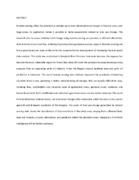| dc.description.abstract | Remote sensing offers the potential to provide up-to-date information
on changes in forestry areas over large areas. Its application makes it possible to
make assessments related to land use change. This research aims to assess whether
land change using remote sensing can provide an efficient alternative, both in terms
of cost and time, including improving forest governance policy support. Remote
sensing and forest governance are state-of-the-art in this research for the devel opment of knowledge from in-depth data analysis. This study was conducted in
Bengkalis-Riau Province, Indonesia because, the regency has become the most
vulnerable region for forest fires since 2013 and the province has experienced
growing pressure from an expanding palm oil industry. It has the largest tropical
peatland area and palm oil plantation in Indonesia. The use of remote sensing
data methods improved the sensitivity of detecting classified forest cover, provid ing a better understanding of changes that are usually difficult to map, including
fires, smallholders and industrial scale of agricultural areas, peatland cover, wet lands, and barren forest land. Both smallholder and industrial agricultural areas
are also better detected. The result from Sentinel data indicate forest, and land
cover changes after evaluation, which focuses on the spatial, spectral, and tempo ral resolution of the imagery. The cover of land use change generated by remote
sensing data shows the classification of land conditions in the study area, ranging
from cultivated land, bare soil, forestry, oil palm plantations, and peatlands within
the plantation area. Integration of artificial intelligence will be further explored. | en_US |
